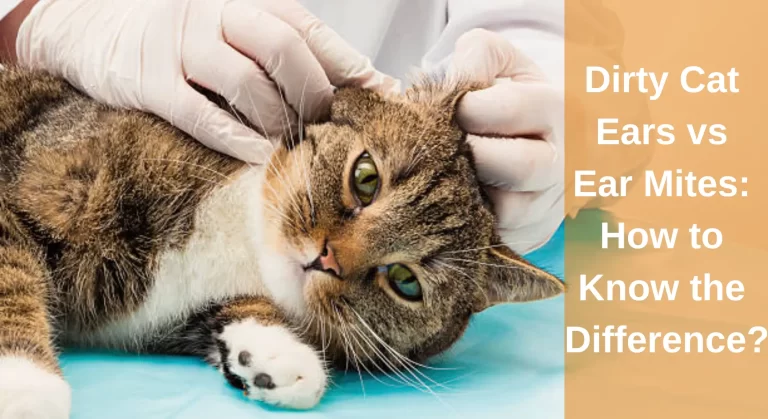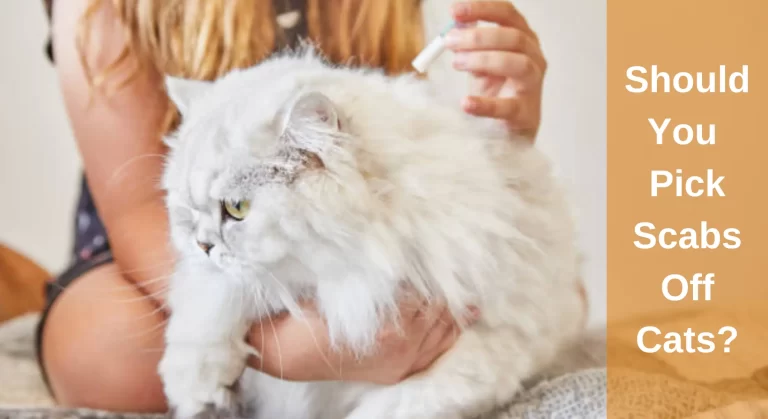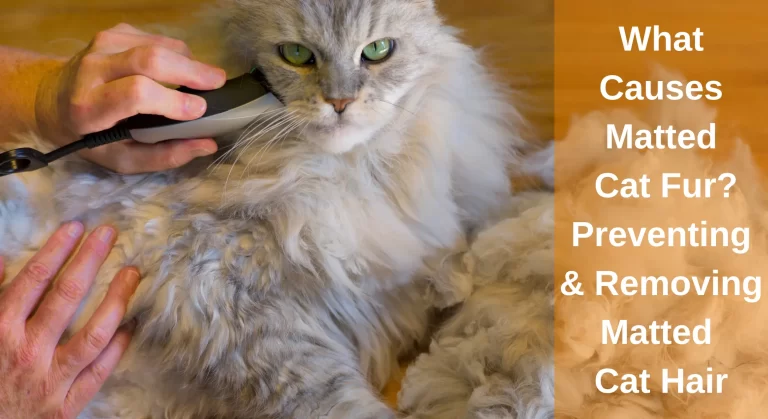Can I Use a Human Toothbrush on My Cat?
Are you among the majority of cat owners who overlook their furry friend’s oral hygiene because you think that felines are pretty skilled at cleaning themselves? Wrong! Though felines are excellent groomers, they struggle to maintain oral hygiene. Cats should clean their teeth frequently like us, to avoid tooth decay and other dental problems. You can help them clean their teeth by brushing them. Now you might think about whether you can use your brush for cats or not. Can I Use a Human Toothbrush on My Cat?
You can use a soft-bristled human toothbrush to clean your cat’s teeth, but with caution. You can use baby toothbrushes because the toothbrush is small and soft to prevent harming your cat’s sensitive gums. Moreover, there are unique cat toothbrushes available, such as finger toothbrushes with little nubs.
It’s recommended to use cat-specific toothpaste and follow a gradual acclimatization process to make the experience comfortable for your cat.
Even if you’re still facing problems while cleaning your cats’ teeth, continue reading this informative post. Here I’ve mentioned every detail you need to know regarding your felines’ oral health and effective techniques that would help you to make your cats’ teeth healthy and clean. Don’t miss it! Scroll down to learn more interesting facts.
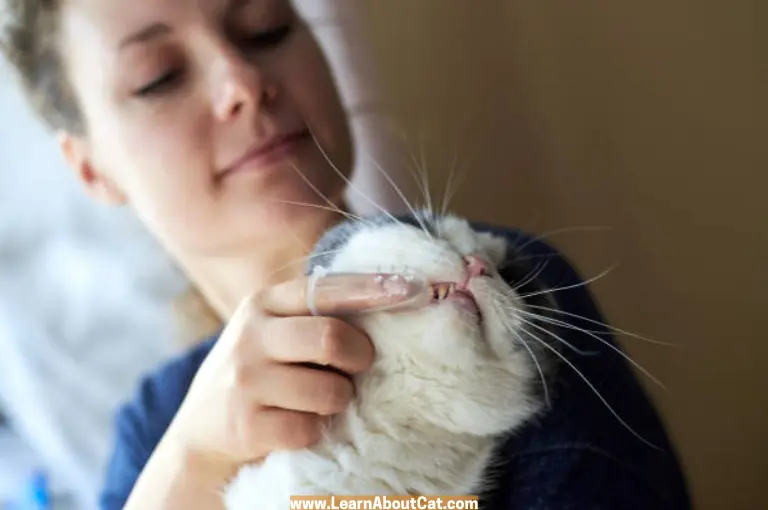
Why Should I Brush My Cat’s Teeth?
Like us, cats can get oral disease and lose their teeth. The prevalent clinical problem affecting adult felines is periodontal disease. Most cats show signs of periodontal disease when they reach the age of three. But don’t worry, it can be prevented. The first step to prevent oral infections in your cat involves brushing his teeth, which also helps to refresh her breath.
Tartar is created when germs adhere to the teeth and cause plaque to accumulate. The accumulation of plaque as well as tartar below the gum line results in periodontitis or other gum diseases. Gum disease causes the gums to enlarge and turn red.
Therefore, it is best to brush your cat’s teeth every day, at least three times per week is beneficial. Although cleaning a cat’s teeth may seem like a difficult task, cats can be trained to tolerate and even like the process if you use the proper method with a good dose of determination and tolerance.
Also, it is preferable to start brushing your cat’s teeth when she’s a kitty to develop this habit. Even if it could take slightly longer when your feline is grown up, the effort will be still worthwhile.
Check Out: Why Your Cat is Making Weird Mouth Movements?
Can I Use a Regular Toothbrush on My Cat?
No, you can’t use a normal human toothbrush on cats. For feline’s sensitive lips and gums, a normal toothbrush’s bristles and overall shape could be too rough or big. It is preferable to use a toothbrush made especially for cats.
Cats’ teeth respond better to cat-specific toothbrushes since they are small in size and include soft bristles. Both pet supply stores and online retailers sell these toothbrushes.
Also, Check Out: My Cat is Not Eating Much But Acting Normal Why?
Can I Brush My Cats Teeth With Toothpaste?
Explore the ins and outs of brushing your cat’s teeth with toothpaste, while considering the safety, benefits, and proper techniques involved.
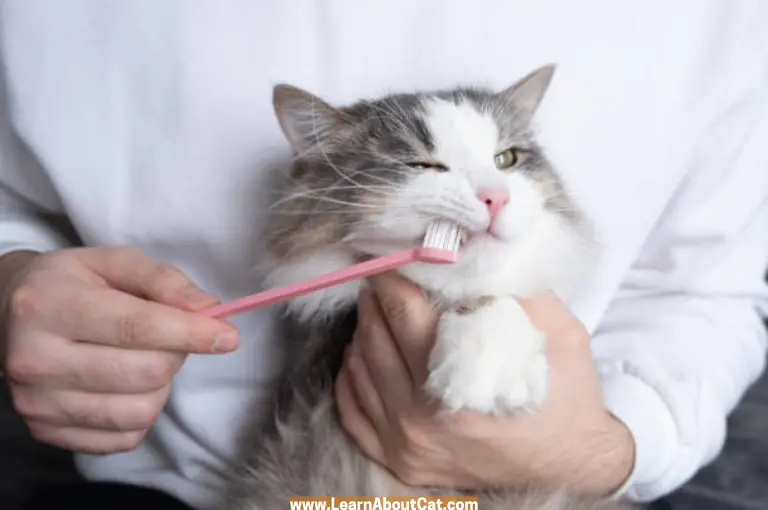
Selecting Cat-Friendly Toothpaste
The toothpaste you use matters significantly. Cat-specific toothpaste is formulated to be safe for your feline friend. Unlike human toothpaste, it doesn’t contain ingredients that could be harmful if ingested by your cat.
These specialized toothpaste options often come in flavors that cats find more appealing, making the brushing experience less stressful.
Benefits of Brushing with Toothpaste
Brushing your cat’s teeth with toothpaste offers several benefits. It helps remove plaque and food debris that can lead to dental issues.
Additionally, the massaging action of brushing can stimulate the gums and improve overall oral health. The inclusion of enzymatic components in some cat toothpaste brands can further aid in breaking down plaque.
The Right Technique for Brushing
Proper technique is crucial when brushing your cat’s teeth. Begin by getting your cat used to the idea of having their mouth touched. Gradually introduce them to the toothpaste by letting them taste a small amount.
Once they’re comfortable, gently lift their lips and use a cat toothbrush or a finger brush to clean their teeth in gentle, circular motions. Focus on the outer surfaces of the teeth, where plaque tends to accumulate.
Frequency of Brushing
Consistency is key to reaping the benefits of toothbrushing. Aim for a routine where you brush your cat’s teeth two to three times a week. This frequency strikes a balance between maintaining their dental health and avoiding unnecessary stress for your cat.
Can I Brush My Cats Teeth Without Toothpaste?
Brushing your cat’s teeth without toothpaste can be a suitable option for several reasons. Firstly, some cats are sensitive to the taste and texture of toothpaste.
Additionally, there are concerns about the ingredients in human toothpaste being harmful to cats if ingested. Brushing without toothpaste can still be effective in removing debris and promoting gum health.
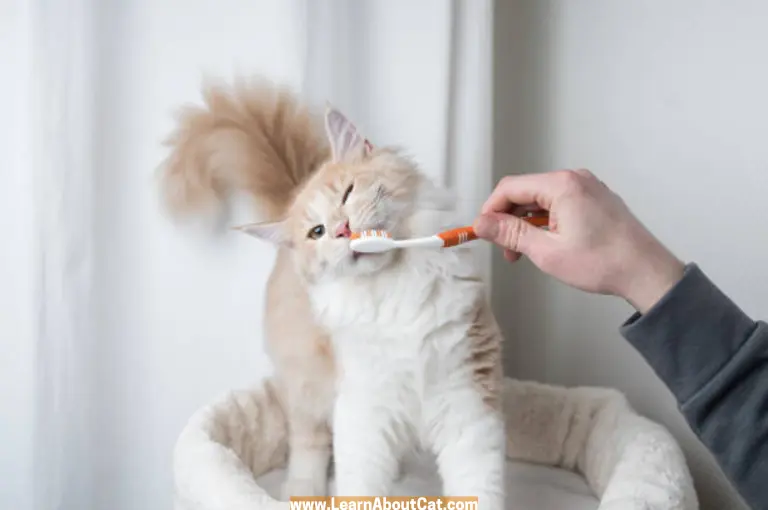
Tools You’ll Need
Before you start brushing, gather the necessary tools: a soft-bristled toothbrush or a finger brush designed for cats, a damp cloth or gauze, and a comfortable and quiet environment to minimize stress for your cat.
Step-by-Step Guide to Brushing Without Toothpaste
- Introducing the Brush: Let your cat get familiar with the toothbrush or finger brush. Allow them to sniff and investigate it, associating it with positive experiences such as treats and petting.
- Gentle Touch: Gently touch the toothbrush to your cat’s teeth and gums without applying pressure. This helps them become accustomed to the sensation.
- Start Brushing: Using the toothbrush or your finger, brush your cat’s teeth using soft, circular motions. Focus on the outer surfaces of the teeth, where plaque tends to accumulate.
- Be Patient: Your cat might take time to get used to the brushing process. Start with short sessions, gradually increasing the duration as they become more comfortable.
Also Read: How to Bathe a Cat or Kitten? -[Step By Step Guide]
Can I Brush My Cats’ Teeth With Human Toothpaste?
NO, you can’t use toothpaste made for humans for cleaning your feline’s teeth. Human toothpaste includes fluoride, detergents, and artificial sweeteners which might be hazardous to cats, ingesting these substances can lead to stomach upset, poisoning, and other health complications.
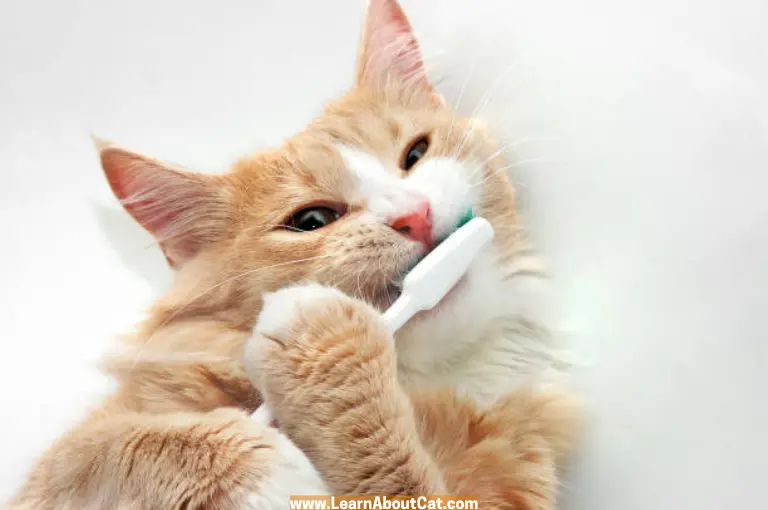
Additionally, some cats may not enjoy the minty taste of toothpaste, besides the reality that it may be a little unpleasant.
Still, if you want to use your toothpaste for cleaning your feline’s teeth, you must remember a few things. Firstly, don’t use fluoride toothpaste and choose cat-specific toothpaste that is safe to use and consume as well.
Second, begin gently and give your feline time to become accustomed to the feeling of getting their teeth cleaned before increasing the amount of toothpaste you apply.
Last but not least, always offer your feline a sip of water immediately after brushing to assist in rinsing any leftover toothpaste.
How to Brush Your Cat’s Teeth?
It may seem difficult to clean your feline’s teeth, but doing so frequently is the most effective way to maintain their dental health.
However, most cats do not tolerate this brushing process, but the majority can adjust if the technique is introduced gradually. Learn how to brush your cats’ teeth by following the below easy steps.
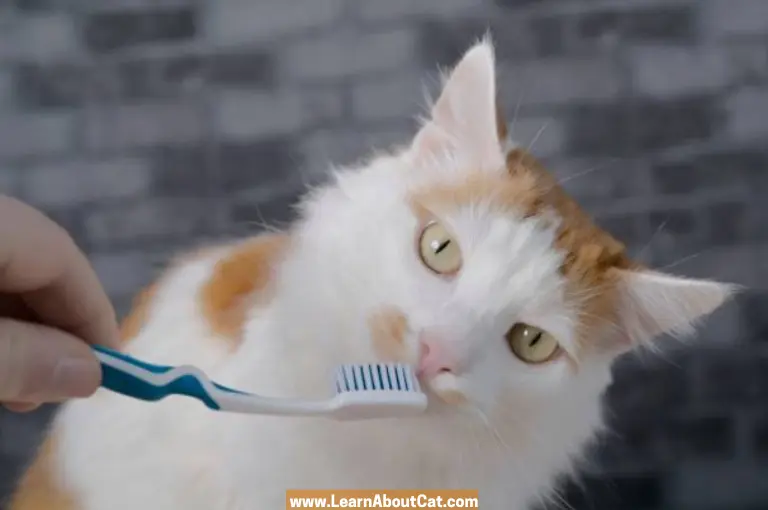
Find Out: How To Train a Cat to Use a Litter Box?
1. Consult With Your Vet for Pet-Safe Toothpaste And a Toothbrush
Use Petsmile professional toothpaste for your cats; it’s vet-approved and safe for animals. Ensure that each feline has its toothbrush if you’ve got multiple cats to prevent the spread of bacteria.
2. Build Trust in Your Cat
Develop trust in your cat before starting to brush his teeth by providing him with just a bit of toothpaste putting on your fingertip. Some felines will adore the flavor right away, whereas others could be a little hesitant.
If your feline is resistant, try applying only a little on its nose. Perhaps your cat will begin to lick it and then after tasting it, they’ll easily get used to brushing.
3. Make Your Cat Used to Touching its Mouth
Before introducing a toothbrush to your cat, ensure that your cat is at ease when you stroke its face and lips with your hands. Expose your cat to the toothbrush at the age of 6 months old; when she’s a tiny kitten. It is wise to get comfortable with the way you will be handling your feline’s head while brushing over the first few days. Follow these guidelines to make your cat comfortable:
- In general, it is preferable to handle your feline from the rear instead of the front. This posture will be less threatening for the feline, doing this will also provide you with improved command if your feline wriggles.
- Place your palm on the top of your feline’s head, pointing backward. The thumb and index finger should be used to grasp the cheekbone beneath the eyes. Stretch your hand openly because a strong but delicate hold is required. To avoid concealing your cat’s sight, raise your first finger.
- Raise your cat’s top lip with your thumb while carefully tilting your cat’s face up.
- You must be able to see all of the fronts of your feline’s teeth if you carefully lower the bottom lip with your thumb of the opposite hand.
- After two to three days of practicing it, use your other hand for holding its bottom lip down, dab a bit of toothpaste on a piece of cotton, and use it to carefully wipe the paste in a clockwise direction on the teeth.
- Request somebody to grasp your feline’s front limbs if it attempts to prevent you by using its paws. Also, you can wrap your cat’s legs in a sheet or blanket.
It is much better to perform these actions frequently unless you and your cat are prepared to move on to the next phase of brushing their teeth.
Also Read: Can I Use Baby Wipes On My Cats? Is it Safe?
4. Make Your Cat Familiar With the Toothbrush
Follow the above instructions, however, this time use the toothbrush rather than your fingertips. The brush should be used on your cat first in that area where they like touching. Then it should be moved slowly toward their mouths.
5. Begin Brushing
You may commence brushing the toothpaste onto your feline’s teeth when it gets used to it; they feel at ease letting their mouth brush. Brush the tooth and the area closest to the gum line, and place the bristles on his teeth at a 45-degree angle.
Take the start from the rear and make little circular movements. Continue by brushing every side for about ten seconds, then slowly increase the period to 30-45 seconds. There can be a little bleeding from your felines’ gums when you initially start brushing your teeth. This isn’t a problem as it makes his gums stronger and from frequent brushing, the bleeding will end.
6. Make a Routine
As cats prefer routine, brush their teeth at a similar time each day. Always use caution when handling the brush, and choose a time when you’re feeling relaxed and at ease. If your feline gets anxious or attempts to flee you must stop brushing him at that time.
7. Select a Peaceful Area
The experience of brushing might be significantly impacted by the place where you’re sitting. For making this process easy and simp, find a peaceful area where your feline feels at ease, like on your lap or another preferred resting location.
What to Use to Clean Your Cat’s Teeth? What Type of Toothbrush Should I Use?
You can use a cat-specific toothbrush and toothpaste made especially to clean your feline’s teeth. Moreover, here are a few instructions that you’ll need to follow to select a brush for your feline’s teeth. You must purchase a toothbrush that is pleasant for your feline to use. Select toothbrushes have small and soft bristles as compared to our toothbrushes.
If your cat is uncomfortable using a conventional toothbrush, a finger toothbrush might be an excellent alternative. These toothbrushes include gentle bristles and adjust easily over your finger. In addition to giving you more control, these toothbrushes are less frightening to your feline.
What Can I Use Instead of a Toothbrush for My Cat? Alternatives to Brushing Cats Teeth
If your feline is resistant to having his teeth cleaned with a toothbrush, you may encourage oral hygiene with other techniques and goods. Here are several possibilities:
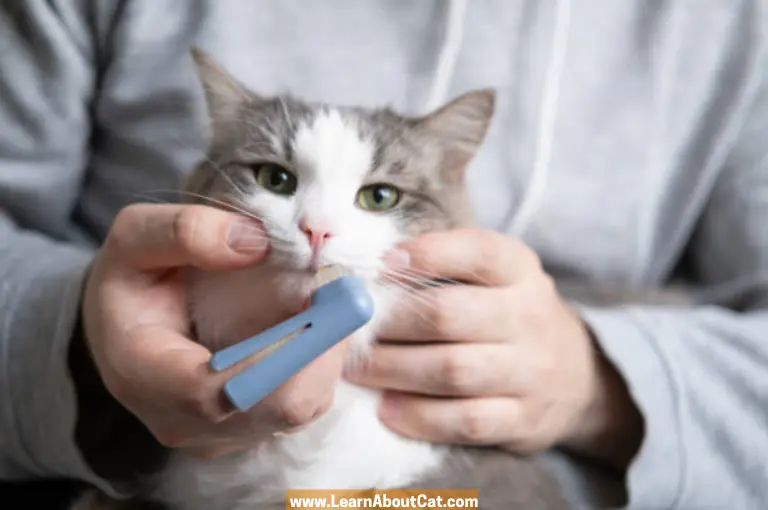
- Dental Wipes: These wipes are used to brush your feline’s teeth as it includes enzymes or dental care products that assist prevent the formation of tartar and plaque. To get rid of dirt and promote good oral hygiene, gently massage your feline’s teeth and gum area with these wipes.
- Dental Sprays: These sprays are sprayed directly into your feline’s teeth to promote fresh breath while boosting oral health because they often include antibacterial characteristics.
- Dental treats: These are made to ensure your feline’s teeth get cleaned while they nibble. These snacks are designed to prevent the formation of calculus and tartar and to improve dental health.
- Water Additives: A few water additives can also support cats’ oral hygiene. When these supplements are added to the water that your cat drinks, the cat’s plaque accumulation is lessened.
It’s crucial to remember that although these options can offer your feline some dental hygiene, they aren’t as beneficial as routine tooth brushing.
What Happens if You Don’t Brush Your Cat’s Teeth?
If you don’t brush your cats’ teeth, then the plaque accumulation on their teeth will cause periodontal disease. Although periodontal disease is uncurable, it might be prevented with proper treatment at home, particularly if you frequently brush your feline’s teeth. But if don’t take care of your cats’ oral hygiene then this disease will lead to gums infection known as gingivitis.
Also, tartar formation on your feline’s teeth hardens over time, mineralizes, and clings to the teeth firmly; can’t be removed by brushing. Additional plaque can form because of the tartar’s extremely abrasive surface.
If these conditions aren’t treated, they’ll lead to more serious types of periodontitis which may harm the tooth’s supportive tissues, particularly the bone surrounding the tooth and the ligament that secures the tooth in its bony hole.
Your feline will experience pain throughout this procedure, which will eventually end up losing teeth. So, it is advisable to frequently brush your feline’s teeth.
How Can I Clean My Cat’s Mouth?
It may be difficult to brush your feline’s teeth, particularly if they aren’t used to it. But you can do the following actions to clean your felines’ mouths:
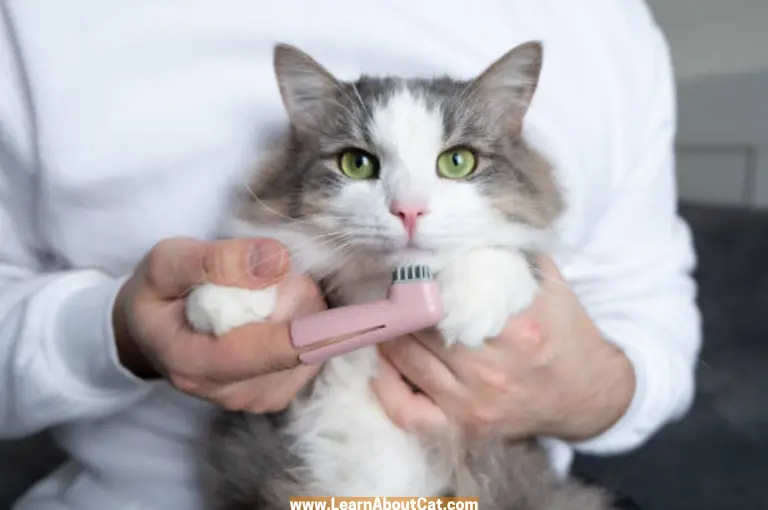
- Slowly introduce a toothbrush for cleaning your cat’s mouth. Start by using your finger to softly touch your cats’ mouths, giving them time to become familiar with the feeling.
- Select a quiet, peaceful duration for your feline. When they’re upset or under stress, don’t try to wipe their teeth.
- Take a dental wipe made for felines or an uncontaminated piece of cotton to wrap your fingertip. Concentrating on the outermost layers of the gums and cavities, gently massage the cotton swab or swipe along them. Dirt and plaque are removed as a result.
- Approaching your cat should be done in a calming quiet manner. To prevent upsetting them, be gentle when wiping their lips. Take a pause and try again afterward if your cat starts to act freaked out or uncooperative.
- It’s important to use encouragement. To help your cat associate mouth cleaning with good things, give him praise, food, or a special activity after every cleaning.
- Your feline’s oral hygiene depends on receiving regular dental examinations from a veterinarian. It’s important to remember that it’s preferable to visit the vet if your feline displays symptoms of dental illness, such as foul breathing, red or inflamed gums, or difficulties eating.
Remember that the best way to clean your feline’s mouth is with delicacy and a slow and steady method.
Home Care Techniques:
Doesn’t matter how hard you try, certain cats don’t like being brushed. In these circumstances, there are some home care measures that you can take to stop cavities and tartar formation:
- If your feline is currently eating soft meals, switching to dry meals or including them in the food they consume could assist you to prevent the buildup of cavities and tartar.
- You can also give them dental chews that are easily available at your veterinarian and even a pet store. Ask your veterinarian about the best dental chews. They are useful in decreasing (but not curing) calculus and tartar buildup.
- If your feline enjoys toothpaste, try putting a little on dry treats or dental treats so it may rub with its teeth. You can also use mouth rinses or gels containing chlorhexidine, an antibacterial agent that helps prevent oral bacterial infection. These aid in reducing oral the development of bacteria, while long-term use may harm tooth enamel.
- Your veterinarian may also recommend a specific “dental diet” for your feline. These foods are specially made for controlling calculus and plaque. These diets are beneficial for felines having dental problems and also for those cats who find brushing very challenging.
Even though it’s probable that your feline may require dental treatment at a certain point in its life, continuous oral home care can significantly enhance teeth health and minimize the need for dental operations.
Frequently Asked Questions
Can you brush your cat’s teeth with Colgate?
You shouldn’t brush your feline’s teeth with toothpaste designed for humans, like Colgate. Cats should avoid using human toothpaste since it includes components that might be dangerous to them, particularly fluoride.
How often should I brush my cats’ teeth?
You must brush your feline’s teeth daily and if you don’t have enough time for regular brushing, you must brush 3 times per week. Also, take them to the dental clinic for a proper checkup once every year.
Do I brush my cat’s tongue?
The tongue of your feline doesn’t need to be brushed. As a cat is a natural groomer so he cleans his own tongue by licking it.
My friend recommended that I use baking soda. Is this okay?
No, you can’t use baking soda for brushing your feline’s teeth because of its strong alkaline composition. Moreover, baking soda can disturb the digestive system’s acid ph if it is consumed. Additionally, your cat might not cooperate if you attempt to clean her teeth with it because baking soda doesn’t taste pleasant.
How much time should I spend brushing my cat’s teeth?
You must brush your cat’s mouth for two to three minutes, preferably once a day.
Wrap Up
In easy words, you can’t use a human toothbrush for cleaning your cat’s teeth as it can be big for your furry friends’ mouths and harsh for their sensitive gums. Moreover, cats don’t enjoy the brushing process, so don’t expect them to collaborate during brushing time.
Therefore, it’s advised to deal with the calmly and use pet-specific toothbrushes and toothpaste. Also, by following the above-mentioned brushing tips your feline will easily get used to brushing.
Lastly, must follow the home care tips for protecting your cat from tartar or other oral diseases. Must take them to the vet clinic for a proper oral checkup.
Who is Isabella?
My name is Isabella, and I am a dedicated and knowledgeable cat enthusiast. With years of experience caring for cats and a deep love for felines, I made a mission to help other cat lovers navigate the challenges of cat ownership.


